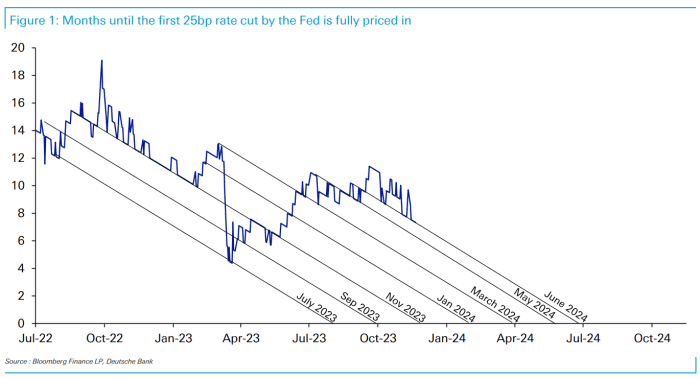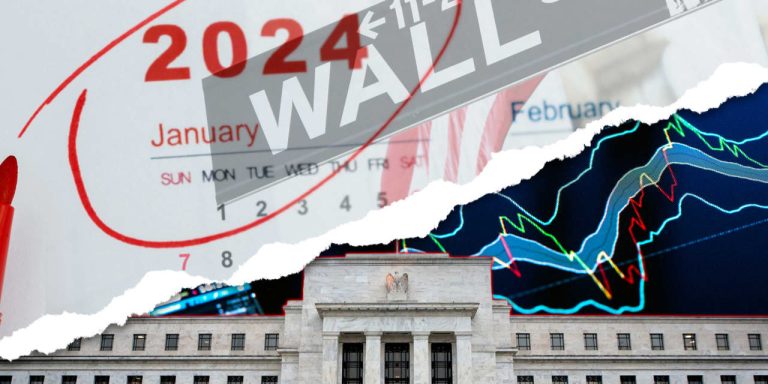Stock investors got off to a shaky start to the new year, hurt by changing expectations about the timing and extent of interest rate cuts by the Federal Reserve in 2024.
The three major U.S. stock indexes snapped a nine-week winning streak on Friday, after unexpectedly strong job gains in December prompted traders to briefly retreat from chances of a March interest rate cut. The S&P 500 SPX and Nasdaq Composite COMP also failed to stage a Santa Claus rally from the final five trading days of 2023 through the first two sessions of 2024, with questions growing about multiple market views of interest rate cuts.
It's all a glimpse of what might be in store for investors in the coming year. Indeed, the so-called “January effect,” or the theory that stocks tend to rise now more than in any other month, could be tested by headwinds that include stalling progress on inflation. The downward trend in inflation in recent months has given traders and investors hope that up to six or seven quarter-point interest rate cuts from the Federal Reserve could be implemented in 2024, starting in March.
However, during the first few days of the new year, reality began to take hold. For one thing, multiple interest rate cuts tend to be more commonly associated with a recession rather than a soft landing for the economy.
Moreover, the idea that the Fed could pursue as many interest rate cuts as traders envision would significantly increase the likelihood that policymakers will lose their battle against inflation, according to Mike Sanders, head of fixed income at Madison, Wisconsin-based Investments. Which manages $23 billion in assets. That's because six or more interest rate cuts would significantly ease financial conditions, he said, and increase the risk of another bout of inflation forcing officials to raise interest rates again.
Minutes from the Fed's December 12-13 meeting show that policymakers were uncertain about their expectations for rate cuts this year and failed to rule out the possibility of another rate hike. However, federal funds futures traders continued to cling to expectations of a significant decline in borrowing costs, with the greater likelihood now to rally around five or six quarter-point rate cuts totaling 125 or 150 basis points of easing by the end of the year. That's nearly double what policymakers expected last month, when they voted to keep interest rates at a 22-year high of 5.25% to 5.5%.

Source: CME FedWatch, as of January 5.
Uncertainty about the path of US interest rates could leave investors in the dark again, weakening the optimism that sent all three major stock indexes in 2023 to their best annual performances in the previous two or three years. In November, analysts at Deutsche Bank AG DB said:
Counted seven times since 2021, markets expected the Fed to take a dovish stance, but they were wrong.

Sources: Bloomberg, Deutsche Bank. Chart as of November 20, 2023.
Todd Thompson, managing director and portfolio partner, said financial markets were operating with “very high expectations” for 2024 rate cuts, but the only way six cuts would be confirmed this year was “a sudden and severe contraction in the economy.” A principal at Reams Asset Management in Indianapolis, which oversees $27 billion.
Heading into 2024, euphoria over the prospect of lower borrowing costs has led to what Thompson calls a “worrying rally in everything,” which he says leaves stocks and high-yield corporate debt vulnerable to a decline between now and the next six months. However, after that period, “the trend is likely to be for lower interest rates as the economy finally succumbs to tightening conditions at the same time that inflation continues to decline.”
Next week brings the next major US inflation update, with the December CPI report due on Thursday. The annual headline rate of inflation from the CPI slowed to 3.1% in November from a peak of 9.1% in June 2022. Additionally, the core rate from the Fed's preferred measure of inflation, known as personal consumption expenditures, fell to 3.2% on a annual. On an annual basis in November compared to an annual rate of 4.2% in July.
The Fed needs to keep interest rates higher because of all the uncertainty surrounding inflation's likely path forward, and the U.S. labor market “will not deteriorate quickly enough in the first quarter to justify a first rate cut in March,” according to Sanders of Federal Reserve Bank. Madison Investments.
Expectations of interest rate cuts “are going to be the issue for 2024, and a lot of it is going to be about getting inflation back to the 2% target,” Sanders said by phone. “We believe that cutting interest rates between 75 and 125 basis points makes sense, and that the first step is more of a June-type event. We do not think it makes sense to cut interest rates in March unless the labor market falls off the cliff.”
History shows that Treasury yields tend to fall in the months leading up to the first rate cut in the Fed's easing cycle. However, this is not happening at the moment. Yields on government debt have been on an upward trend since the end of December, with 2- BX:TMUBMUSD02Y,
10- BX: TMUBMUSD10Y,
And 30-year yields BX:TMUBMUSD30Y end on Friday at their highest levels in more than two to three weeks.
See also: What history says about the stock and bond market before the first Fed rate cut
While financial markets generally tend to be efficient processors of information, they “have not been very precise about pricing in interest rate cuts” this time, said Lawrence Gillum, chief fixed income strategist for the Charlotte, North Carolina-based brokerage firm. Trader for LPL Financial. The big risk for 2024, he said, is if financial conditions ease too much and the Fed declares victory over inflation too early, which could ignite price pressures in a way reminiscent of the 1970s under former Fed Chairman Arthur Burns.
“We believe that interest rate cut expectations have gone too far, too quickly, and the support in yields we are seeing now is market recognition that interest rate cuts probably will not be as strong as what has been priced in,” Gillum said via email. phone.
Thursday's December CPI report is the most important data for next week.
Consumer credit data for November is scheduled to be released on Monday, followed the next day by trade deficit numbers for the same month.
On Wednesday, the November wholesale inventory report and comments from New York Fed President John Williams will be released.
Initial weekly unemployment claims will be released on Thursday. The Producer Price Index for December will be released on Friday.

